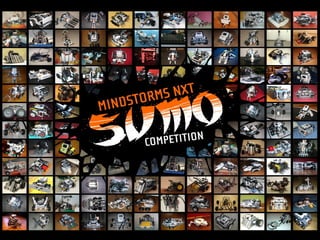Sumo Robotics Competition
•Transferir como PPT, PDF•
1 gostou•1,138 visualizações
Denunciar
Compartilhar
Denunciar
Compartilhar

Recomendados
Mais conteúdo relacionado
Mais procurados
Mais procurados (20)
Semelhante a Sumo Robotics Competition
Semelhante a Sumo Robotics Competition (20)
Scrum and-xp-from-the-trenches 04 sprint demo & retrospective

Scrum and-xp-from-the-trenches 04 sprint demo & retrospective
Discussing Design: The Art of Critique - Web 2.0 Expo NY 2011

Discussing Design: The Art of Critique - Web 2.0 Expo NY 2011
Dynamic programming, Branch and bound algorithm & Greedy algorithms 

Dynamic programming, Branch and bound algorithm & Greedy algorithms
Systematic Inventive Thinking and Process improvements

Systematic Inventive Thinking and Process improvements
Mais de Philip Sweezey (8)
Standards of Practice for School Library Learning Commons in Canada 2014

Standards of Practice for School Library Learning Commons in Canada 2014
Último
Mehran University Newsletter is a Quarterly Publication from Public Relations OfficeMehran University Newsletter Vol-X, Issue-I, 2024

Mehran University Newsletter Vol-X, Issue-I, 2024Mehran University of Engineering & Technology, Jamshoro
This presentation was provided by William Mattingly of the Smithsonian Institution, during the fourth segment of the NISO training series "AI & Prompt Design." Session Four: Structured Data and Assistants, was held on April 25, 2024.Mattingly "AI & Prompt Design: Structured Data, Assistants, & RAG"

Mattingly "AI & Prompt Design: Structured Data, Assistants, & RAG"National Information Standards Organization (NISO)
God is a creative God Gen 1:1. All that He created was “good”, could also be translated “beautiful”. God created man in His own image Gen 1:27. Maths helps us discover the beauty that God has created in His world and, in turn, create beautiful designs to serve and enrich the lives of others.
Explore beautiful and ugly buildings. Mathematics helps us create beautiful d...

Explore beautiful and ugly buildings. Mathematics helps us create beautiful d...christianmathematics
This presentation was provided by William Mattingly of the Smithsonian Institution, during the third segment of the NISO training series "AI & Prompt Design." Session Three: Beginning Conversations, was held on April 18, 2024.Mattingly "AI & Prompt Design: The Basics of Prompt Design"

Mattingly "AI & Prompt Design: The Basics of Prompt Design"National Information Standards Organization (NISO)
Último (20)
ICT Role in 21st Century Education & its Challenges.pptx

ICT Role in 21st Century Education & its Challenges.pptx
Measures of Dispersion and Variability: Range, QD, AD and SD

Measures of Dispersion and Variability: Range, QD, AD and SD
Mattingly "AI & Prompt Design: Structured Data, Assistants, & RAG"

Mattingly "AI & Prompt Design: Structured Data, Assistants, & RAG"
SECOND SEMESTER TOPIC COVERAGE SY 2023-2024 Trends, Networks, and Critical Th...

SECOND SEMESTER TOPIC COVERAGE SY 2023-2024 Trends, Networks, and Critical Th...
Explore beautiful and ugly buildings. Mathematics helps us create beautiful d...

Explore beautiful and ugly buildings. Mathematics helps us create beautiful d...
Mattingly "AI & Prompt Design: The Basics of Prompt Design"

Mattingly "AI & Prompt Design: The Basics of Prompt Design"
Seal of Good Local Governance (SGLG) 2024Final.pptx

Seal of Good Local Governance (SGLG) 2024Final.pptx
Sumo Robotics Competition
- 2. Mindstorms Sumo Competition Two self-controlled robots are placed in a ring and try to avoid falling out or avoid being pushed out by the opponent robot. The first robot that touches outside of the ring loses the round. The first robot to win two rounds, wins the match.
- 3. Rules/Guidelines • The robot can only be made from the pieces in your kit. • At the start of each round, Lego Sumo robots must not exceed 35 centimeters in width and/or depth.Robots may expand to any size after starting. • There is no height limit, as soon as movement is allowed in a round, the robot may then twist, fall, and/or expand without size limits.
- 5. Identify Problem/Design Brief • Identification of the problem that requires a solution. • The Design Brief is a short description of the task and conditions associated with solving the problem.
- 6. Investigation and Research • Once the goals are outlined research is done to find information about similar problems and resources available. Standing on the shoulders of giants
- 7. Identification of Possible Solutions • Identifying solutions is a brainstorming activity to determine the possible ways of solving a specific design problem.
- 8. Selection of the Best Solution • Picking the best solution means just that – evaluate the solution ideas formed in the previous step and pick the “best” one.
- 9. Development of the Solution • During this step the details of the solution are defined and preparation is made for the construction/ implementation of the solution.
- 10. Modeling and Prototyping • The chosen solution is created, built, made, etc.
- 11. Testing and Evaluation • Testing and evaluating the solution is a trial to see if the solution actually solves the design problem identified.
- 12. Redesigning and Improving • The redesigning and improving of a solution can continue forever. During this step students act upon some of the findings from the previous Testing and Evaluation phase to improve their design.
- 13. Things to Consider • What sensor(s) to use? • How to program? • Mass, Newton’s laws • Friction • Gearing • Wheel size • Power level • Make it sturdy
- 14. Things to Consider 2 • Detecting the opponent – Touch sensor – US sensor(s) • Consider the “center of gravity”
- 15. How to Program a Sumo Robot • Make the robot move around in the ring – Basic Sumo: • Repeat the following forever: – Go forward until the edge – Backward slightly – Spin right
- 17. Make sure the Power! • Default power level is 75% • Fully charge your battery!!! • How to check the voltage level? – See the icon on the LCD
